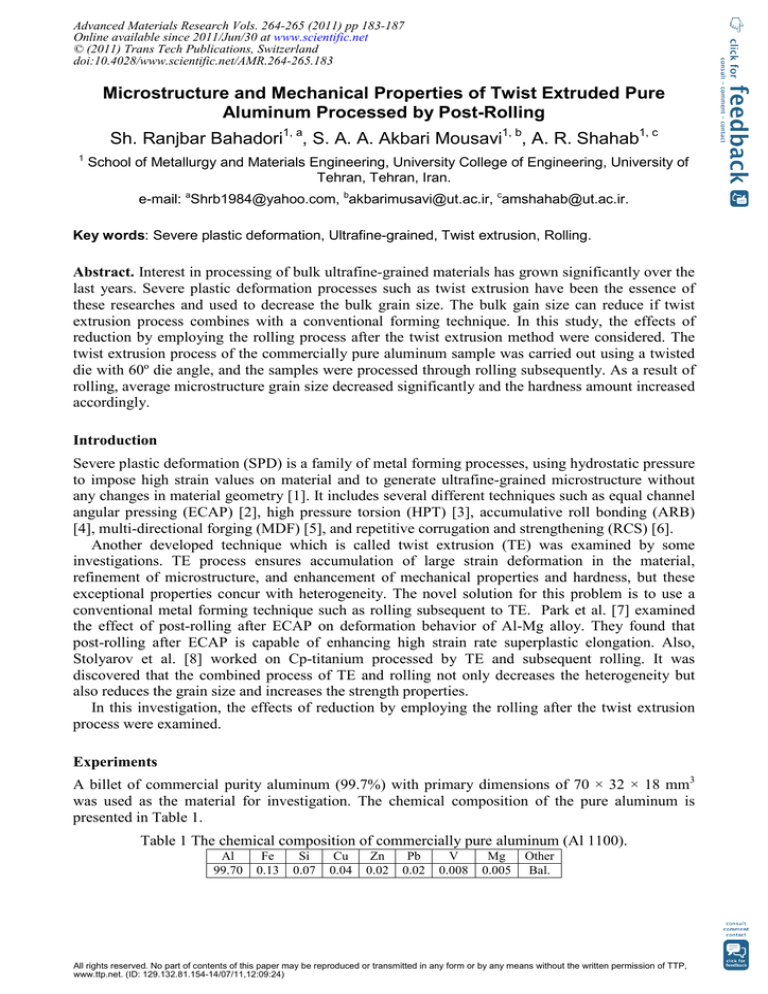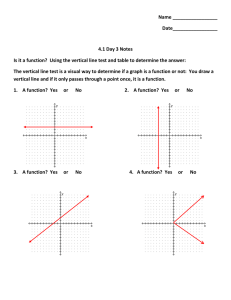
Advanced Materials Research Vols. 264-265 (2011) pp 183-187
Online available since 2011/Jun/30 at www.scientific.net
© (2011) Trans Tech Publications, Switzerland
doi:10.4028/www.scientific.net/AMR.264-265.183
Microstructure and Mechanical Properties of Twist Extruded Pure
Aluminum Processed by Post-Rolling
Sh. Ranjbar Bahadori1, a, S. A. A. Akbari Mousavi1, b, A. R. Shahab1, c
1
School of Metallurgy and Materials Engineering, University College of Engineering, University of
Tehran, Tehran, Iran.
e-mail: aShrb1984@yahoo.com, bakbarimusavi@ut.ac.ir, camshahab@ut.ac.ir.
Key words: Severe plastic deformation, Ultrafine-grained, Twist extrusion, Rolling.
Abstract. Interest in processing of bulk ultrafine-grained materials has grown significantly over the
last years. Severe plastic deformation processes such as twist extrusion have been the essence of
these researches and used to decrease the bulk grain size. The bulk gain size can reduce if twist
extrusion process combines with a conventional forming technique. In this study, the effects of
reduction by employing the rolling process after the twist extrusion method were considered. The
twist extrusion process of the commercially pure aluminum sample was carried out using a twisted
die with 60º die angle, and the samples were processed through rolling subsequently. As a result of
rolling, average microstructure grain size decreased significantly and the hardness amount increased
accordingly.
Introduction
Severe plastic deformation (SPD) is a family of metal forming processes, using hydrostatic pressure
to impose high strain values on material and to generate ultrafine-grained microstructure without
any changes in material geometry [1]. It includes several different techniques such as equal channel
angular pressing (ECAP) [2], high pressure torsion (HPT) [3], accumulative roll bonding (ARB)
[4], multi-directional forging (MDF) [5], and repetitive corrugation and strengthening (RCS) [6].
Another developed technique which is called twist extrusion (TE) was examined by some
investigations. TE process ensures accumulation of large strain deformation in the material,
refinement of microstructure, and enhancement of mechanical properties and hardness, but these
exceptional properties concur with heterogeneity. The novel solution for this problem is to use a
conventional metal forming technique such as rolling subsequent to TE. Park et al. [7] examined
the effect of post-rolling after ECAP on deformation behavior of Al-Mg alloy. They found that
post-rolling after ECAP is capable of enhancing high strain rate superplastic elongation. Also,
Stolyarov et al. [8] worked on Cp-titanium processed by TE and subsequent rolling. It was
discovered that the combined process of TE and rolling not only decreases the heterogeneity but
also reduces the grain size and increases the strength properties.
In this investigation, the effects of reduction by employing the rolling after the twist extrusion
process were examined.
Experiments
A billet of commercial purity aluminum (99.7%) with primary dimensions of 70 × 32 × 18 mm3
was used as the material for investigation. The chemical composition of the pure aluminum is
presented in Table 1.
Table 1 The chemical composition of commercially pure aluminum (Al 1100).
Al
99.70
Fe
0.13
Si
0.07
Cu
0.04
Zn
0.02
Pb
0.02
V
0.008
Mg
0.005
Other
Bal.
All rights reserved. No part of contents of this paper may be reproduced or transmitted in any form or by any means without the written permission of TTP,
www.ttp.net. (ID: 129.132.81.154-14/07/11,12:09:24)
184
Advances in Materials and Processing Technologies II
The billet was annealed at 500 ºC for 2.5 h and air quenched immediately. Then, it passed
through a twisted channel with the slope angle (β) of 60º and the rotation angle (α) of 90º as
illustrated in Fig. 1. TE was performed for one pass at room temperature. Afterwards, cross cold
rolling was carried out up to a total reduction of 65%.
The microstructures of the superficial longitudinal cross-section of the TEed samples with and
without subsequent rolling were examined by optical microscope (OM) of OLYMPUS. Moreover,
grain size measurements were performed using the linear intercept method.
Fig. 1 The schematic of a billet during the twist extrusion process.
Hardness tests were performed on the samples prepared for microstructure observations. The
Brinell hardness test (HB) was employed by an ESEWAY hardness tester using 30 Kg/mm2 load.
At least five separate measurements were performed on each sample.
Results and discussion
Microstructure evolutions. Fig. 2 shows the microstructures of the as-received and as-annealed
samples. It shows that grain coarsening would occur after annealing as the grain size increases from
600 µm to 859 µm.
Fig. 2 The OM microstructure of the superficial longitudinal cross-section of pure aluminum in the
(a) as-received, and (b) as-annealed conditions.
Advanced Materials Research Vols. 264-265
185
Fig. 3 illustrates the superficial microstructures of TEed samples with and without post-rolling;
hereafter, the former and the latter are denoted as the TE and TE + CR, respectively. The TE sample
includes grains of 150 µm (Fig. 3a) and the TE + CR sample comprises finer grains of
80 µm
stretched along the rolling direction.
Fig. 3 The OM microstructure of the superficial longitudinal cross-section of pure aluminum in the
(a) TE and (b) TE + CR conditions.
The effects of repeated TE passes were examined in previous experiment [9]. Fig. 4 shows by
performing two and three TE passes the mean grain size decreases from 859 µm to 100 µm and
65 µm, respectively. Hence, it can be concluded that the mean grain size caused by the combined
process of TE + CR is the same as the one resulted by three TE passes.
Fig. 4 The OM microstructure of the superficial longitudinal cross-section of pure aluminum
processed by (a) two TE passes and (b) three TE passes [9].
Moreover, according to Fig. 5 by performing four ECAP passes, the mean grain size of the
superficial cross-section decreases from 400 µm to 75 µm [10]. As a comparison, the specimen
experiences more grain refinement during the combined process of TE + CR than four ECAP passes
(Table 2).
186
Advances in Materials and Processing Technologies II
Fig. 5 The mean grain size values versus the number of ECAP passes for commercially pure
aluminum [10].
Therefore, it may be suggested that repeated TE and ECAP passes can be replaced by the
conventional rolling to make it industrial without losing the SPD unique properties. Besides this
advantage, by using of rolling, the heterogeneity of mechanical properties is reduced efficiently
[10].
Table 2 The grain size values of pure aluminum during the different stages of ECAP, TE and TE
+ CR processes.
Process
As-annealed
1 pass
2 pass
3 pass
4 pass
CR
ECAP [10]
400
280
120
80
75
-
TE [9]
859
140
100
65
-
-
TE + CR
859
150
-
-
-
80
Hardness variations. Table 3 summarizes the hardness values of pure aluminum samples during
different stages of TE and TE + CR processes. The initial hardness of specimen is 25 HB. By
conducting the first TE pass, the hardness amount increases to 36.6 HB and enhances to 46.9 HB
after performing CR. On the other hand, by employing three TE passes the hardness value increases
from 25 HB to 45 HB. Therefore, both TE and TE + CR processes cause almost the same maximum
hardness value.
Fig. 6 shows the variations of the Vickers hardness with the number of ECAP passes performed on
pure aluminum at room temperature [11]. Applying three ECAP passes results in maximum
hardness value of about 44.1 HV, which is almost equal to TE + CR hardness amount. Hence, it
shows that both processes cause the same mechanical properties.
Table 2 The Brinell hardness values for the TE and TE + CR processes of commercially pure
aluminum
Sample
Three TE passes [11]
TE + CR
As-annealed
25
25
1 TE pass
38
36.6
2 TE passes
42
-
3 TE passes
45
-
TE + CR
46.9
Advanced Materials Research Vols. 264-265
187
Fig. 6 The variations of Vickers hardness values with the number of ECAP passes for commercially
pure aluminum [11].
Conclusions
1. A commercially pure aluminum was subjected to one TE pass with and without subsequent
rolling. By performing TE the grains of about 150 µm was developed. Although post-rolling
resulted in elongated grains, it lessened the mean grain size to 80 µm.
2. This paper drew a comparison between TE + CR and ECAP and illustrated that the decrease in
grain size by applying four ECAP passes and three TE passes is the same as combined TE + CR
technique. Therefore, repeated passes of SPD can be replaced by conventional forming method.
3. The hardness variations reflected the enhancement of mechanical properties by performing
subsequent rolling. Also, hardness values of TE + CR were the same as three ECAP passes and
three TE passes. This matter is advantageous for SPD methods to be used in an industrial route.
References
[1] R. Z. Valiev, Y. Estrin, Z. Horita, T. G. Longdon, M. J. Zehetbauer, Y. T. Zhu: JOM Vol. 58 (4)
(2006), p. 33.
[2] V. M. Segal, V. I. Reznikov, A. E. Drobyshevskiy, V. I. Kopylov: Metally Vol. 1 (1981), p. 99.
[3] N. A. Smirnova, V.I. Levit, V.I. Pilyugin, R. I. Kusnetsov, L. S. Davydova, V. A. Sazonova:
Fiz. Met. Metalloved Vol. 61 (1986), p. 1170.
[4] Y. Saito, H. Utsunomiya, T. Sakai, R. G. Hong: Mater. Sci. Forum Vol. 304-306 (1999), p. 73.
[5] G. A. Salishchev, O.R. Valiakhmetov, R. M. Galeyev: J. Mater. Sci Vol. 28 (1993), p. 2898.
[6] J. Y. Huang, Y. T. Zhu, H. G. Jiang, T. C. Lowe: Acta Mater Vol. 49 (2001), p. 1479.
[7] K. T. Park, H. J. Lee, C. S. Lee, D. H. Shin: Mater. Sci. Eng. A Vol. 393 (2005), p. 118.
[8] V. V. Stolyarov, Y. E. Beygelzimer, D. V. Orlov, R. Z. Valiev: Phys. Met. Metall Vol. 99
(2005), p. 204.
[9] A. R. Shahab, Design, simulation and manufacturing of twist extrusion in order to produce bulk
ultra fine grained structures in copper, aluminum and titanium, M. Sc. Thesis, School of
Metallurgy and Materials Engineering, University College of Engineering, University of
Tehran, Iran (2007), p. 89.
[10] W. Skrotzki, N. Scheerbaum, C. G. Ortel, H. G. Brokmeier, S. Suwas, L. S. Toth: Acta Mater
Vol. 55 (2007), p. 2211.
[11] Y. Chen, Y. Li, L. He, C. Lu, H. Ding, Q. Li: Mater. Letters Vol. 62 (2008), p. 2821.
Advances in Materials and Processing Technologies II
doi:10.4028/www.scientific.net/AMR.264-265
Microstructure and Mechanical Properties of Twist Extruded Pure Aluminum
Processed by Post-Rolling
doi:10.4028/www.scientific.net/AMR.264-265.183

